Who was Margaret Thatcher & what did she do?
(This is a page for children - with a quiz at the end)
Margaret Thatcher was Britain's prime minister (or 'PM') for almost 12 years between 1979 and 1990. She was the first woman ever to hold that job, or to lead any big country in Europe or America, and became famous the world over.
She was often called "the Iron Lady", and in fact was pleased when she was given the nickname - by a Russian newspaper - because she believed in being a strong leader.
When she became PM many people in Britian wondered whether a woman would be strong enough to do this very difficult job? She showed them the answer to that question was 'yes'. When women become leaders of countries, they are often compared to Margaret Thatcher, even when they are really very different people.
1925-1947: childhood
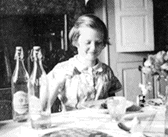
She was born "Margaret Hilda Roberts" in Grantham, a small town in eastern England, on 13 October 1925. Her parents, Alf and Beatrice Roberts, ran a grocery and she lived over the shop, sometimes helping behind the counter. She had an older sister called Muriel, but no brothers or other close family.
When she was born the town was still recovering from the Great War of 1914-18. There were fewer children than usual because so many men had been away fighting, and some of them were killed. As she grew older people began to be worried there would be another war. Unfortunately they were right. The Second World War broke out in 1939 when she was 14 and lasted till 1945 when she was 20.
Also during her childhood lots of people had no jobs and had very little money. The Roberts family was luckier than most and did baking for people who were unwell or didn't have enough to eat, which people from their church took round. They went to services together twice every Sunday.
So she grew up at a time when terrible things were happening in the world and life was much harder than it is today. But people helped each other and they were very proud of their town and their country.
There was no television when she was small (the very first tv programmes were shown in Britain when she was 14, but she didn't see them). And of course there were no computers and no internet. But there were cinemas! She loved films, which were a new thing when she was a child. Most came from America and she watched as many as she could. Also radio started when she was small. She was very excited the day the family got its first radio and ran all the way home from school. The whole family would listen most evenings to favourite programmes, like quizzes, comedies and news.
She went to state schools - even when she was very small she had to walk several miles there and back each day (except when there was a radio to run for) - and worked hard, winning a place at Oxford University when she was 18 to study chemistry, a subject she loved. Her teacher at Oxford was a famous chemist who later won a Nobel Prize for her work.
But what she really wanted to do was to go into politics. Her father - she called him "Pa" - was very interested in what was happening in the world and helped to run the local council. She enjoyed listening to him talk about how things worked, and he knew a lot, so that was one reason she was became a politician. She first helped at an election when she was 10, the age she was in the picture just above.
At university she won her first election, becoming president of the student Conservative Association. It was only a small election, but some famous politicians came to speak to her club and she made some useful friends who helped her later.
1947-1959: Candidate for parliament & getting married
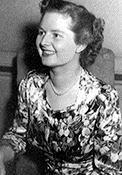
After university she got her first job as a chemist and tried to become the Member of Parliament (or MP) for a town called Dartford in Kent, on the edge of London. She tried twice, in 1950 and 1951. She didn't come close to winning, because most voters in Dartford supported the Labour Party. But she was the youngest woman candidate in the country, and very pretty, so her picture was in lots of newspapers. The photo to the left shows how she looked at this time. She hugely enjoyed fighting the elections.
It was in Dartford that she met and married Denis Thatcher, so becoming "Margaret Thatcher" (let's just call her MT for short). He was older than her and had fought in the war. They were a very close couple and he gave her tremendous help and support in everything she did. They had twins in 1953, Mark and Carol. In those days fathers weren't usually present at the birth of their children. Denis was at a cricket match when they were born and when he first saw the babies said they looked like rabbits without fur on. He was always cracking jokes.
After MT got married she decided to train as a lawyer, something which she had planned to do for some years. She was always very determined and managed the hard work even though she had small children. A nanny helped her. She tried to find other places where she could stand for Parliament but it was difficult, partly because lots of Conservatives felt that women with young children should not have careers. But after years of trying she was chosen to be the Conservative candidate for Finchley, in north London, and finally became an MP in October 1959.
1959-1970: new girl in parliament
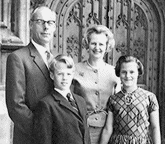
Just after being elected MT entered a kind of competition among MPs to win the chance to pass a law. She won first time and got her own law written, meeting important people in Parliament and impressing other MPs with her first speech (called a "maiden speech"). She gave her first ever tv interview the next day, at home on the sofa with the twins on either side of her.
Soon she was asked to become a member of the government, responsible for pensions and benefits. She was good at understanding all the complicated rules, and worked hard.
She began to become quite well known and in 1970, when a man called Edward Heath became PM, she was given the important job of Education Secretary, responsible for Britain's schools and colleges.
1970-1974: Education Minister
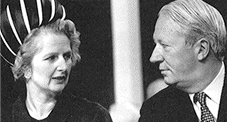
MT had a bad time as Education Minister, especially in her first year. She was attacked by people who were annoyed that she had abolished free school milk for older children and got the nickname "milk snatcher". There were lots of other arguments too, and she was unhappy for a time, but it the end she was made stronger by the experience and many of her critics came to realise how tough a person she was.
Sadly she did not got on very well with the PM (the man in the picture on the left). His government had to cope with serious economic problems. There were many strikes in Britain, great crises abroad, and he changed his plans in what became called "the U turn" (named after someone turning their car all the way round to go in the opposite direction to the one they started in). After only four years he was beaten at an election in February 1974 and lost power.
1975-1979: Leader of the Opposition
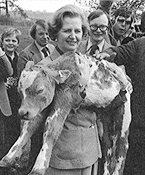
After the election the Conservatives argued about what had gone wrong. Had the U turn been a mistake? MT thought it had been, and later made a famous speech when she said "You turn if you want to. The lady's not for turning". There was another election in October 1974 and they lost that one too.
Many Conservatives were very critical of their leader and to almost everyone's surprise in February 1975 MT was voted by Conservative MPs to replace him. Even her husband Denis told her she wouldn't win. There were many men who had been hoping and expecting to get the job, some of whom were bad losers. Others were very nice about it. She became the first woman ever to lead a political party in a country like Britain. Because her party wasn't in power, but was much the largest party opposed to the government, she became "Leader of the Opposition".
She did that job for four years. The Labour Government she opposed struggled with terrible economic problems, which Conservatives thought they made far worse by having the wrong policies. The big argument was over how to make the economy work better. Conservatives thought the thing was to reduce the amount that government did, and especially the amount it spent and took from people in taxes to pay for spending. They thought too that there should be fewer strikes and wanted to change the law to bring that about (for example, by making trade unions hold a vote before calling a strike). The Labour Party said the Conservative plans would make the economy worse and were unfair.
For a long time it was not clear who would win the argument. But over the winter of 1978/79, there were so many strikes causing so many problems that Labour's support collapsed. The newspapers called it "the Winter of Discontent". The government lost an important vote in the House of Commons and had to hold an election, which the Conservatives won easily. The photo (above left) of MT holding a calf comes from that election campaign, when she went to a farm and the photographers wanted good pictures for tv and the newspapers. It seemed a bit silly to her, but she didn't mind: in politics you sometimes have to do odd things like that so that people will notice you and remember.
The day after the election, 4 May 1979, MT became Prime Minister and spoke to people outside Downing Street explaining what she hoped to do. You can watch film of what she said from a link lower down this page.
1979-1983: Prime Minister – first term
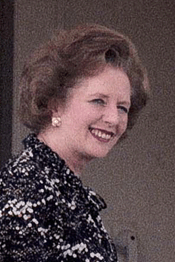
The last few PMs had had a rough time and MT found things no different in her new job. Her government felt it had to do some painful things, particularly putting up interest rates to stop prices rising too fast (which is called inflation). As a result lots of people lost their jobs (known as unemployment). The policies were very unpopular at first and there were many protests and criticisms.
But in time things began to improve. Prices stopped rising so fast and the economy began to grow again.
Then there was an unpredicted event: a war began over the Falklands Islands, 8,000 miles from Britain off the coast of South America. The islands were British and the people living there wanted things to stay that way. But the government of Argentina claimed the islands were theirs and invaded them in April 1982. Britain sent a Task Force of ships and soldiers to recapture them. Attempts to solve the problem by discussion failed, but military action was quickly successful and the Falklands were back under British control by June 1982.
Most people in Britain were impressed, as were many around the world. MT became still better known for her 'Iron Lady' toughness, as well as more confident in herself. And when the next election came, in June 1983, the government was voted back into office with an even higher share of support.
1983-1987: Prime Minister – Second Term
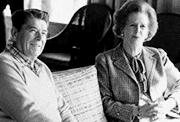
MT's second term as PM opened with almost as many problems as the first. The miners' union called a strike which last an entire year, from 1984-85. The union was defeated, after a huge battle which caused lasting bitterness, and quietly many of MT's opponents in the Labour Party began to think that her reforms could not be reversed.
In October 1984, when the strike was still going on, the Irish Republican Army (IRA) attempted to murder MT and many of her colleagues by bombing their hotel in Brighton during the Conservative Party annual conference. Although she survived unhurt, some of her closest friends were among the injured and dead. The room next to her bedroom was severely damaged, so the attackers came close to killing her.
Some Conservatives had always been uneasy with MT as leader. In January 1986 one of these critics, the Defence Minister Michael Heseltine, suddenly resigned, walking right out of a meeting at No.10 Downing Street in a dispute over the troubles of the British helicopter maker called Westland. MT survived the crisis, but she was shaken by it. There was talk of the government and of its leader being 'tired', of having gone on too long.
MT's reply to the critics was characteristic of her: she announced her plans for a third Thatcher Government! With the economy now very strong, prospects were good for an election and the government was voted in again.
She had now become a very well known international figure, with a particularly close relationship to the US President Ronald Reagan (pictured). She was at the height of her power at the time this photo was taken. They were both very critical of the Communist policies of the Soviet Union, which had been involved in a kind of "Cold War" with Western Europe and the US since the late 1940s. By "Cold War" people meant a conflict that didn't involve actual fighting directly between the powers themselves, but lots of tension and threat all the same.
1987-1990: Prime Minister – Third Term
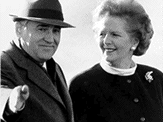
MT now began her last term in office. There were huge reforms of education, local government and health care, all of them very controversial. One was quickly reversed - the introduction of a new way of paying for local government, "the poll tax" - but the others have lasted longer and governments after hers built on them.
There were big disputes between MT and her closest colleagues over Britain's relations with the European Community (EC), which we had joined in 1973. MT had become more and more critical of the EC over time and made a speech at Bruges in September 1988 which began to turn her party into a 'Euro-sceptic' one.
In these years the Cold War began to come to an end, an event in which MT played her part. She helped to strengthen of the Western alliance against the Soviets in the early 1980s by supporting the strong defence policies of Ronald Reagan and then helped to encourage a peaceful solution to the conflict when a new and much friendlier leader emerged in the Soviet Union, Mikhail Gorbachev. She invited him to Britain in December 1984 and said afterwards he was a man she could do business with. You can see from the photo that they got on well.
By late 1990, the Cold War was over. But that event triggered new arguments about Europe, as France revived the idea that there should be a single European currency to limit the power of Germany (which had been divided till the end of the Cold War). As a result, divisions over European policy within the British Government were deepened.
On November 1 1990 one of MT's longest serving colleagues, Sir Geoffrey Howe, resigned over Europe and in a bitter resignation speech encouraged a challenge to MT's leadership by Michael Heseltine. In the vote that followed, she won a majority. Yet under party rules a second vote was still required. Receiving the news at a conference in Paris, she announced straight away that she would fight on.
But a political earthquake occurred the next day on her return to London, when many colleagues — unsympathetic to her views on Europe and doubting that she could win a fourth election — suddenly deserted her leadership and left her no choice but to withdraw. She resigned as PM on November 28 1990. John Major succeeded her and held the job until the landslide election of Tony Blair's Labour Government in May 1997.
Biography: Conclusion
After 1990 Lady Thatcher (as she became) remained a powerful political figure. She wrote two best-selling volumes of memoirs - The Downing Street Years (1993) and The Path to Power (1995) - and for 12 years toured the world lecturing.
In March 2002 she announced she was giving up public speaking, on doctor's advice.
Denis Thatcher, her husband for more than fifty years, died in June 2003. She was very sad to lose him.
People still argue a lot about MT. Critics claim that many of her policies were too harsh and hurt people. Defenders say she made the Britain economy work much better and that made most people better off. But critics and supporters agree in thinking that MT's time as PM was very important in British history.
She was not very well in her last years and became quite forgetful. But she still enjoyed life and had many friends and admirers.
She died in April 2013 and was buried in a grand ceremonial funeral at St Paul's Cathedral. The Queen attended, as well as the Prime Minister and many famous people from all over the world. Her coffin was carried by soldiers from the Welsh Guards, a regiment which had fought bravely in the Falklands War.
Quiz: test what you remember!
- Who was the first to call MT "the Iron Lady"?
- Where was she born and brought up?
- Why when she was born were there fewer children in her town than normal?
- What was her favourite subject at school?
- Where did she meet her husband?
- What did he think the twins looked like when they were new born?
- What was MT's first job in government?
- What was her nickname as Education Minister?
- When did she become leader of the Conservative Party?
- Why did she agree to be photographed holding a calf?
- What islands did Britain fight Argentina over in 1982?
- Which minister resigned by walking right out of a meeting in 1986?
- What was the name of the US President she was especially friendly with?
- Who was the man she thought she could do business with?
Email us the result and we will tell you how many you got right
Links: some things to see
She was worried she might forget her lines so jotted down notes on a tiny card (also on this site). Can you spot when she glances down at the card?
This is the most famous bit from a famous speech.
News had just come in that we had recaptured one of the islands invaded by the Argentinians. The war was not yet over, but it was good news.
She had already decided to resign when she made this speech, which was hugely admired for its courage and style.
